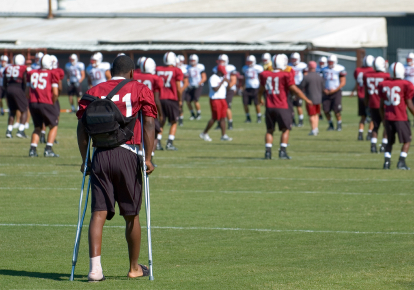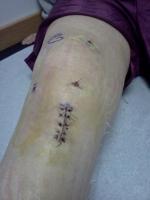Ankle Rehab and Treatment
Ankle rehab is something that is often overlooked. This is especially true with ankle sprains. So many times an ankle sprain is seen as a minor injury, not needing any type of rehabilitation. Just ice and rest, and it will be better in a few weeks. That is exactly what leads to chronic problems and repeat ankle sprains.
Below are the major things that any ankle treatment and rehab exercise program should focus on. If you are currently rehabbing an ankle injury, make sure that your program covers all of these areas.
Whether you have had an ankle sprain, ankle surgery, or any other type of ankle injury, you need to have some type of rehabilitation. It may be something you can do at home, or you may want to visit a clinic and work with an athletic trainer or physical therapist.
Initial Treatment
The first step in treating an ankle injury is determining exactly what is going on. This is best accomplished with a visit to your doctor, athletic trainer, or physical therapist. A comprehensive evaluation can determine what structures are injured, and the appropriate course of action - whether that is rehabilitation, home care, or possibly surgery.
Initial ankle injuries that occur with an acute mechanism, like an ankle sprain, need to be treated for pain and swelling. The common use of Rest, Ice, Compression, and Elevation can help to control early swelling and pain, and get your recovery off on the right foot.
Once you have controlled the initial injury, and had an evaluation to determine the exact diagnosis, then you need to consider ankle rehabilitation. Even minor injuries like ankle sprains can benefit from rehab. And there are common things that every rehab program needs to focus on.
Improving Range of Motion
Depending
on the severity of your injury, you may have some range of motion loss.
This is often caused by swelling, pain, or muscle
weakness. By addressing these factors, your range of motion should
improve.
There
are a few exercises that you can do to work on your range of motion.
They start with simple active range of motion exercises to tolerance,
like pointing your toes, and then pulling them towards you, turning
your foot in and out, and making circles or spelling out the alphabet.
Calf stretching is another way to improve ankle range of
motion.
Make
sure that your ankle rehab program involves some type of range of
motion activity, especially in the early stages after injury. I cannot stress enough how important it is to restore normal range of motion and mobility at the ankle and foot. The ankle is the connection between your body and the ground, and if you have limited mobility in your ankle, the forces that are transmitted through your lower extremity are altered, causing abnormal stresses, often in the knee, hip, or lower back.
Improving Strength
Strength of the ankle muscles is important to help
provide stability. Even more important than strength is neuromuscular control. The ankle ligaments
contain proprioceptors that provide feedback to the muscles, telling them when to
contract and relax. Weak muscles are unable to perform their job of
stabilizing the ankle, and this can lead to future sprains, or chronic
pain.
The most important muscles to
strengthen are the peroneals. They are the major
stabilizers of the ankle. The peroneals create the motion of eversion at the ankle. Eversion is the direct opposite direction of inversion, which is how most ankle sprains occur. Strengthening of the peroneals and improving your neuromuscular control is essential during ankle rehab.
The
most common ankle exercises to improve strength are theraband
exercises, as well as closed chain activities like lunges, step ups,
and heel raises.
Make sure that your ankle rehab
program
involves strengthening of all of the ankle muscles,
paying special
attention to the peroneals and posterior tibialis. Don't forget weight
bearing exercises like lunges and heel raises.
Matter of Balance
Balance is really a combination of several different systems working together.
The proprioceptive system, which involves all of the sensory information coming into the body via the proprioceptors and nerves (senses of touch, hot, cold, pressure, pain, movement, and position).
The visual system, which includes all of the things you see in your environment, and the vestibular system.
Improving Balance
Balance
is very important during sports activities. The ankle is the keystone
of the lower extremity when it comes to balance. It all begins at the
ankle, and the ability to remain in a stable position for the rest of
the body to stand upon.
Balance is made up of proprioception, visual cues, and
body awareness. The best way to improve balance is to practice
balancing. Improving balance
leads to improved proprioception, and improved function. This is the
most commonly overlooked component of ankle rehab, especially if you
are doing your own treatment at home.
Simple single
leg
balancing is a great ankle exercise to start with. Then you can
progress to more challenging exercises like balancing on unstable
surfaces or adding movements.
Your ankle program
must have some type of balance component
in order to be successful.
All good ankle rehab programs focus on improving range of motion, strength, and balance. There are a lot of different exercises that can help to achieve these goals. Whether you are doing your own rehab at home, or working to treat your injury in a clinic, make sure your program addresses each of these areas.
More Information
-
Ankle Sprain Solutions
A downloadable ebook with everything you need to treat your ankle sprain.
- Foot Pain Solutions
A comprehensive program for treating foot and ankle pain.
SII › Ankle Rehab

